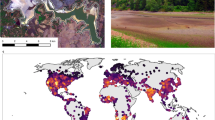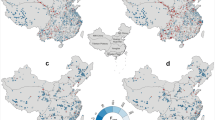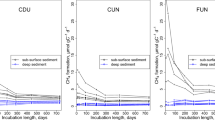Abstract
Reservoirs are essential for human populations, but their global carbon footprint is substantial (0.73–2.41 PgCO2-equivalent yr−1). Yet the temporal evolution of reservoir carbon emissions and their contribution to anthropogenic radiative forcing remains unresolved. Here we quantify the long-term historical and future evolution (1900–2060) of cumulative global reservoir area, carbon dioxide and methane emissions and the resulting radiative forcing. We show that global reservoir carbon emissions peaked in 1987 (4.4 TmolC yr−1) and have been declining since, due largely to decreasing carbon dioxide emissions as reservoirs age. However, reservoir-induced radiative forcing continues to rise due to ongoing increases in reservoir methane emissions, which accounted for 5.2% of global anthropogenic methane emissions in 2020. We estimate that, in the future, methane ebullition and degassing flux will make up >75% of the reservoir-induced radiative forcing, making these flux pathways key targets for improved understanding and mitigation.
This is a preview of subscription content, access via your institution
Access options
Access Nature and 54 other Nature Portfolio journals
Get Nature+, our best-value online-access subscription
$29.99 / 30 days
cancel any time
Subscribe to this journal
Receive 12 print issues and online access
$259.00 per year
only $21.58 per issue
Buy this article
- Purchase on Springer Link
- Instant access to full article PDF
Prices may be subject to local taxes which are calculated during checkout





Similar content being viewed by others
Data availability
References
St. Louis, V. L., Kelly, C. A., Duchemin, É., Rudd, J. W. M. & Rosenberg, D. M. Reservoir surfaces as sources of greenhouse gases to the atmosphere: a global estimate. Bioscience 50, 766–775 (2000).
Roland, F. et al. Variability of carbon dioxide flux from tropical (Cerrado) hydroelectric reservoirs. Aquat. Sci. 72, 283–293 (2010).
Barros, N. et al. Carbon emission from hydroelectric reservoirs linked to reservoir age and latitude. Nat. Geosci. 4, 593–596 (2011).
Deemer, B. R. et al. Greenhouse gas emissions from reservoir water surfaces: a new global synthesis. Bioscience 66, 949–964 (2016).
Hertwich, E. G. Addressing biogenic greenhouse gas emissions from hydropower in LCA. Environ. Sci. Technol. 47, 9604–9611 (2013).
Harrison, J. A., Prairie, Y. T., Mercier‐Blais, S. & Soued, C. Year‐2020 global distribution and pathways of reservoir methane and carbon dioxide emissions according to the Greenhouse Gas from Reservoirs (G‐res) model. Glob. Biogeochem. Cycles 35, 1–14 (2021).
Bastviken, D., Tranvik, L. J., Downing, J. A., Crill, P. M. & Enrich-Prast, A. Freshwater methane emissions offset the continental carbon sink. Science 331, 50 (2011).
Rosentreter, J. A. et al. Half of global methane emissions come from highly variable aquatic ecosystem sources. Nat. Geosci. 14, 225–230 (2021).
Johnson, M. S. et al. Spatiotemporal methane emission from global reservoirs. J. Geophys. Res. Biogeosci. https://doi.org/10.1029/2021jg006305 (2021).
Prairie, Y. T. et al. A new modelling framework to assess biogenic GHG emissions from reservoirs: the G-res tool. Environ. Model. Softw. 143, 105117 (2021).
Deemer, B. R. & Holgerson, M. A. Drivers of methane flux differ between lakes and reservoirs, complicating global upscaling efforts. J. Geophys. Res. Biogeosci. 126, e2019JG005600 (2021).
Abril, G. et al. Carbon dioxide and methane emissions and the carbon budget of a 10-year old tropical reservoir (Petit Saut, French Guiana.). Glob. Biogeochem. Cycles 19, GB4007 (2005).
Teodoru, C. R. et al. The net carbon footprint of a newly created boreal hydroelectric reservoir. Global Biogeochem. Cycles 26, GB2016 (2012).
Yan, X., Thieu, V. & Garnier, J. Long-term evolution of greenhouse gas emissions from global reservoirs. Front. Environ. Sci. https://doi.org/10.3389/fenvs.2021.705477 (2021).
Zarfl, C., Lumsdon, A. E., Berlekamp, J., Tydecks, L. & Tockner, K. A global boom in hydropower dam construction. Aquat. Sci. 77, 161–170 (2015).
Keller, P. S., Marcé, R., Obrador, B. & Koschorreck, M. Global carbon budget of reservoirs is overturned by the quantification of drawdown areas. Nat. Geosci. 14, 402–408 (2021).
Facts About Hydropower (International Hydropower Association, 2022); https://www.hydropower.org/iha/discover-facts-about-hydropower
Prairie, Y. T. et al. Greenhouse gas emissions from freshwater reservoirs: what does the atmosphere see? Ecosystems 21, 1058–1071 (2018).
Galy-Lacaux, C., Delmas, R., Kouadio, G., Richard, S. & Gosse, P. Long-term greenhouse gas emissions from hydroelectric reservoirs in tropical forest regions. Glob. Biogeochem. Cycles 13, 503–517 (1999).
Venkiteswaran, J. J. et al. Processes affecting greenhouse gas production in experimental boreal reservoirs. Glob. Biogeochem. Cycles 27, 567–577 (2013).
Matthews, C. J. D. et al. Carbon dioxide and methane production in small reservoirs flooding upland boreal forest. Ecosystems 8, 267–285 (2005).
Yvon-Durocher, G. et al. Methane fluxes show consistent temperature dependence across microbial to ecosystem scales. Nature 507, 488–491 (2014).
Beaulieu, J. J., DelSontro, T. & Downing, J. A. Eutrophication will increase methane emissions from lakes and impoundments during the 21st century. Nat. Commun. 10, 3–7 (2019).
Soued, C. & Prairie, Y. T. The carbon footprint of a Malaysian tropical reservoir: measured versus modelled estimates highlight the underestimated key role of downstream processes. Biogeosciences 17, 515–527 (2020).
Lee, D. S. et al. The contribution of global aviation to anthropogenic climate forcing for 2000 to 2018. Atmos. Environ. 244, 117834 (2021).
Meinshausen, M., Raper, S. C. B. & Wigley, T. M. L. Emulating coupled atmosphere–ocean and carbon cycle models with a simpler model, MAGICC6 – part 1: model description and calibration. Atmos. Chem. Phys. 11, 1417–1456 (2011).
Myhre, G. et al. in Climate Change 2013: The Physical Science Basis (eds Stocker, T. F. et al.) 659–740 (Cambridge Univ. Press, 2013).
Ocko, I. B. et al. Unmask temporal trade-offs in climate policy debates. Science 356, 492–493 (2017).
Encinas Fernández, J., Hofmann, H. & Peeters, F. Diurnal pumped-storage operation minimizes methane ebullition fluxes from hydropower reservoirs. Water Resour. Res. 56, e2020WR027221 (2020).
Nash, J. E. & Sutcliffe, J. V. River flow forecasting through conceptual models part I—a discussion of principles. J. Hydrol. 10, 282–290 (1970).
Lehner, B. et al. High-resolution mapping of the world’s reservoirs and dams for sustainable river-flow management. Front. Ecol. Environ. 9, 494–502 (2011).
Lovelock, C. E. et al. in 2019 Refinement to the 2006 IPCC Guidelines for National Greenhouse Gas Inventories Vol. 4 (eds Agus, F. et al.) Ch. 7 (TFI, 2019).
Rubel, F. & Kottek, M. Observed and projected climate shifts 1901–2100 depicted by world maps of the Koppen–Geiger climate classification. Meteorol. Zeitschrift 19, 135–141 (2010).
Ubierna, M., Diez Santos, C. & Mercier-Blais, S. in Water Security Under Climate Change (eds Biswas, A. & Tortajada, C.) 69–94 (Springer, 2021); https://doi.org/10.1007/978-981-16-5493-0
Ciais, P. et al. in Climate Change 2013: The Physical Science Basis (eds Stocker, T. F. et al.) 465–570 (Cambridge Univ. Press, 2013); https://doi.org/10.1017/CBO9781107415324.015
SSP Database Version 2.0 (IIASA, 2018): https://tntcat.iiasa.ac.at/SspDb/dsd?Action=htmlpage&page=about
Etminan, M., Myhre, G., Highwood, E. J. & Shine, K. P. Radiative forcing of carbon dioxide, methane, and nitrous oxide: a significant revision of the methane radiative forcing. Geophys. Res. Lett. 43, 12614–12623 (2016).
Lehner, B. et al. Global Reservoir and Dam (GRanD) database. Global Dam Watch https://globaldamwatch.org/grand/ (2011).
Acknowledgements
This study was funded by the UNESCO Chair in Global Environmental Change held by Y.T.P. through which C.S., S.M.-B. and Y.T.P. were funded. J.A.H. was funded by an NSF INFEWS grant (NSF EAR 1639458), an NSF DEB Grant (no. 135211), a GRIL Fellowship Grant and a Stanford University Cox Visiting Professorship.
Author information
Authors and Affiliations
Contributions
All authors contributed to conceptualization and data analysis. S.M.-B. performed data curation. J.A.H. and Y.T.P. acquired funding. C.S. wrote the original draft, and all authors reviewed and edited the manuscript.
Corresponding author
Ethics declarations
Competing interests
The authors declare no competing interests.
Peer review
Peer review information
Nature Geoscience thanks Xingchen Yan, Lluís Gómez-Gener, Ronny Lauerwald and the other, anonymous, reviewer(s) for their contribution to the peer review of this work. Primary Handling Editor: Thomas Richardson, in collaboration with the Nature Geoscience team.
Additional information
Publisher’s note Springer Nature remains neutral with regard to jurisdictional claims in published maps and institutional affiliations.
Supplementary information
Supplementary Data 1
Numerical dataset.
Rights and permissions
Springer Nature or its licensor holds exclusive rights to this article under a publishing agreement with the author(s) or other rightsholder(s); author self-archiving of the accepted manuscript version of this article is solely governed by the terms of such publishing agreement and applicable law.
About this article
Cite this article
Soued, C., Harrison, J.A., Mercier-Blais, S. et al. Reservoir CO2 and CH4 emissions and their climate impact over the period 1900–2060. Nat. Geosci. 15, 700–705 (2022). https://doi.org/10.1038/s41561-022-01004-2
Received:
Accepted:
Published:
Issue Date:
DOI: https://doi.org/10.1038/s41561-022-01004-2
This article is cited by
-
Elevated hydrostatic pressure enhances the potential for microbially mediated carbon sequestration at the sediment–water interface in a deep-water reservoir by modulating functional genes and metabolic pathways
Carbon Research (2024)
-
The mediating role of renewable energy, sectoral output and economic growth on greenhouse gas emissions: African regional perspective
Environmental Science and Pollution Research (2023)
-
The world’s reservoirs are ageing — and belching out more methane
Nature (2022)



